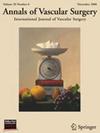Engineering Approach to Study the Effect of TEVAR on the Cardiovascular System: A Systematic Review
IF 1.4
4区 医学
Q3 PERIPHERAL VASCULAR DISEASE
引用次数: 0
Abstract
Background
To study the effect of endovascular treatment of the thoracic aorta on cardiac geometry and evaluate the effects of stent placement on hemodynamics and cardiovascular biomechanics.
Methods
Articles were selected through the use of online databases such as PubMed, Scopus, and Web of Science, investigating the use of engineering methods (computational analysis and simulations using three-dimensional models of cardiovascular structures obtained from medical imaging) to study the effects of pretreatment and posttreatment Thoracic Endovascular Aortic Repair (TEVAR) in terms of left ventricular mass variation and assessment of fluid dynamics parameters such as Wall Shear Stress (WSS), flow variations, and velocity. The quality of the included studies was assessed using the Newcastle-Ottawa scale.
Results
A total of 11 studies were considered: 3 reported data on left ventricular mass variation, 5 reported flow and velocity variations, and 6 provided information on WSS. A high discrepancy in results and methodology for conducting the analyses was observed. Overall, an increase in left ventricular mass was observed in patients undergoing TEVAR, while an improvement in flow conditions and stress was noted following the exclusion of the pathological aortic zone.
Conclusions
To summarize, TEVAR can result in changes in vascular structures. However, the current literature on this topic is limited and the analysis methods used vary in terms of methodology, treated pathology, and follow-up duration. To successfully integrate computational simulations and engineering evaluations of medical images into clinical practice, it is crucial to standardize the analysis methods.
研究TEVAR对心血管系统影响的工程方法:系统综述。
目的研究胸主动脉血管内治疗对心脏几何形状的影响,并评估支架置入对血液动力学和心血管生物力学的影响:通过使用 PubMed、Scopus 和 Web of Science 等在线数据库筛选出文章,这些文章调查了使用工程学方法(使用从医学影像中获得的心血管结构三维模型进行计算分析和模拟)研究 TEVAR(胸腔内主动脉修复术)治疗前后对左心室质量变化的影响,以及对流体动力学参数(如壁剪应力 (WSS)、流量变化和速度)的评估。纳入研究的质量采用纽卡斯尔-渥太华量表进行评估:共考虑了 11 项研究:3 项研究报告了左心室质量变化数据,5 项研究报告了流量和速度变化,6 项研究提供了室壁剪切应力(WSS)信息。研究结果和分析方法存在很大差异。总体而言,接受 TEVAR 手术的患者左心室质量有所增加,而在排除病理主动脉区后,血流状况和压力均有所改善:综上所述,TEVAR 可导致血管结构的改变。然而,目前有关这一主题的文献有限,而且所使用的分析方法在方法学、治疗病理和随访时间方面也各不相同。要成功地将医学影像的计算模拟和工程评估融入临床实践,关键是要规范分析方法。
本文章由计算机程序翻译,如有差异,请以英文原文为准。
求助全文
约1分钟内获得全文
求助全文
来源期刊
CiteScore
3.00
自引率
13.30%
发文量
603
审稿时长
50 days
期刊介绍:
Annals of Vascular Surgery, published eight times a year, invites original manuscripts reporting clinical and experimental work in vascular surgery for peer review. Articles may be submitted for the following sections of the journal:
Clinical Research (reports of clinical series, new drug or medical device trials)
Basic Science Research (new investigations, experimental work)
Case Reports (reports on a limited series of patients)
General Reviews (scholarly review of the existing literature on a relevant topic)
Developments in Endovascular and Endoscopic Surgery
Selected Techniques (technical maneuvers)
Historical Notes (interesting vignettes from the early days of vascular surgery)
Editorials/Correspondence

 求助内容:
求助内容: 应助结果提醒方式:
应助结果提醒方式:


